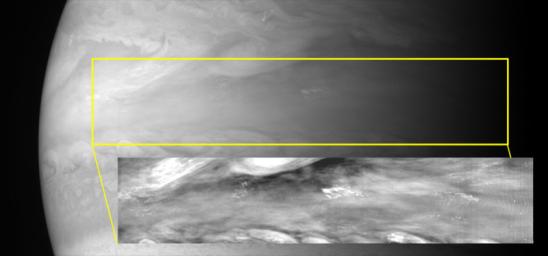Atmospheric Waves
Caption:
With its Multispectral Visible Imaging Camera (MVIC), half of the Ralph instrument, New Horizons captured several pictures of mesoscale gravity waves in Jupiter's equatorial atmosphere. Buoyancy waves of this type are seen frequently on Earth - for example, they can be caused when air flows over a mountain and a regular cloud pattern forms downstream. In Jupiter's case there are no mountains, but if conditions in the atmosphere are just right, it is possible to form long trains of these small waves. The source of the wave excitation seems to lie deep in Jupiter's atmosphere, below the visible cloud layers at depths corresponding to pressures 10 times that at Earth's surface. The New Horizons measurements showed that the waves move about 100 meters per second faster than surrounding clouds; this is about 25% of the speed of sound on Earth and is much greater than current models of these waves predict. Scientists can "read" the speed and patterns these waves to learn more about activity and stability in the atmospheric layers below.
Cataloging Keywords:
| Name |
Value |
Additional Values |
| Target |
Jupiter |
|
| System |
Jupiter |
|
| Target Type |
Planet |
|
| Mission |
New Horizons |
|
| Instrument Host |
New Horizons |
|
| Host Type |
Flyby Spacecraft |
|
| Instrument |
Multispectral Visible Imaging Camera (MVIC) |
|
| Detector |
|
|
| Extra Keywords |
Atmosphere, Color, Mountain |
| Acquisition Date |
|
| Release Date |
2007-10-09 |
| Date in Caption |
|
|
| Image Credit |
NASA/Johns Hopkins University Applied Physics Laboratory/Southwest Research Institute |
| Source |
photojournal.jpl.nasa.gov/catalog/PIA10097 |
| Identifier |
PIA10097 |

